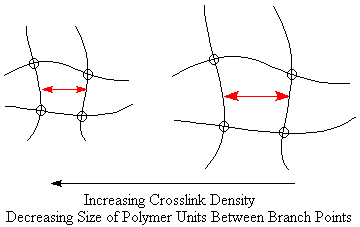

You also know that in the intro page IPNs were described by two distinct networks that were interpenetrating (intermeshed) with each other so intimately, that the components did not phase seperate. Then in a couple of other places, it was mentioned that this conceptual picture of an IPN is wrong. So what is going on?
Most IPNs phase separate just as their corresponding (linear) blends do because of a low entropy of mixing and positive heats of mixing. However, the formation of network structures restrict the domain size significantly in IPNs. A simple depiction of the phase separation in an IPN is shown below. The dark regions represent one component phase and the dark purple domains are the other component phase. We will assume that the dark regions represent the first component in a sequential IPN. Although the morphology in an IPN is never ordered enough to show a "lattice" type structure, it shows a couple of important points. First of all, that the dark regions "divide" the second component into small domains. Second even though there are two distinct phases, it can be readily seen that both phases are continuous. In other words, both phases span the entire sample. More will be said on this in a minute.

The key concept here at work in IPNs is the size of the domains. In an immiscible polymer blend, the polymer often phase seperate into domains larger than micrometers and have a very poor interface. This is the reason for the often poor mechanical properties and opaque appearance of immiscible blends. The domains of IPNs are typically along the order of 10-100 nanometers, which gives them optical clarity and an enormous amount of interface between the two components. Whether they like it or not, the material at the domain surface are at least partially mixed with the other component. Therefore there is a significant amount of semi-compatiblized components in an IPN. Some of the consequences of this of this semi-compatibilization are discussed in Examples of IPNs. To gain a further appreciation for the size of of the domains present, remember that most polymer chains are longer than 10 nanometers if they are stretched out into an extended chain. Therefore the size of the domains may be smaller than the polymer chains making up the domain.
Many researchers have occupied their time over the past 30 or so years by studying the morphology of IPNs and how it relates to their properties. It is way beyond the scope of this page to discuss this subject at any great length; that is what the references are for. In any case, here are some of the more significant facts regarding IPNs and morphology:

Click here to learn more about some of these techniques.
 How about taking a
little quiz on the material on this page to see how well you learned it.
How about taking a
little quiz on the material on this page to see how well you learned it.